Samsung Galaxy Note 10.1 (2014 Edition) Review
by Brian Klug & Anand Lal Shimpi on October 1, 2013 9:00 AM EST- Posted in
- Tablets
- Samsung
- Mobile
- Galaxy Note 10.1
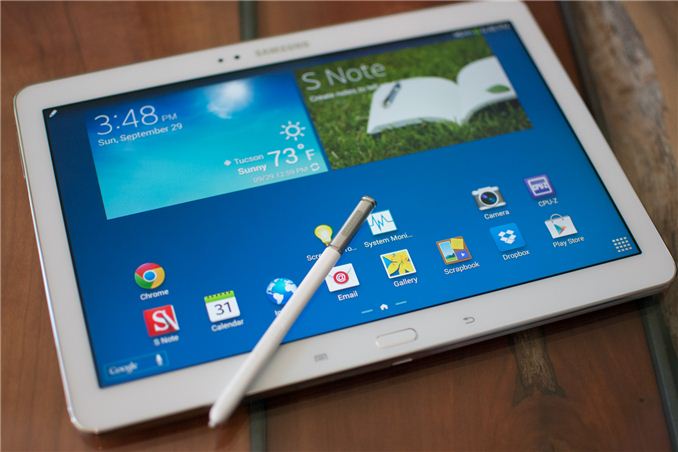
Ever since the arrival of the Nexus 10, it’s been hard recommending other, lower resolution 10-inch Android tablets. Although not the knock out success that the Nexus 7 became, the Nexus 10 did offer a good alternative to the iPad at a lower price. Given that Samsung made the aforementioned 10-inch Nexus, complete with 2560 x 1600 display, we wondered when a similar panel might grace Samsung’s own tablet lineup. A few weeks ago we got the answer we’ve been waiting almost a year for.
The latest iteration of Samsung’s Galaxy Note 10.1, aptly named the 2014 Edition, ships with the firm’s own 10.1-inch 2560 x 1600 display. It’s not display alone that Samsung hopes to sell its latest Note 10.1 on, the rest of the package is similarly specced to the max.
Unlike the Galaxy Note 3 where the majority of devices sold will likely use Qualcomm’s Snapdragon 800, the new Note 10.1 uses Samsung’s own Exynos 5420 SoC for all WiFi models. It’s only the LTE versions that will leverage Qualcomm silicon, but WiFi tablets still sell extremely well. All of this makes the 2014 Edition the first Samsung Android device to ship with its own Cortex A15 silicon in the US since the Nexus 10.
Add 3GB of RAM, tick the 802.11ac box and all you’re missing is USB 3.0 from the Galaxy Note 3. The result is Samsung’s first truly high end 10.1-inch Android tablet since the Nexus 10, and as its name implies, it comes with an S Pen. The entire bundle comes at a $150 premium to the much lower specced Galaxy Tab 3 10.1 and to the Galaxy Note 8.0:
| Specifications | |||||||||
| Samsung Galaxy Note 10.1 (2014 Edition) | Samsung Galaxy Tab 3 10.1 | Samsung Galaxy Note 8.0 | |||||||
| Dimensions | 243.1 x 171.4 x 7.9mm | 210.8 x 135.6 x 7.95mm | 210.8 x 135.6 x 7.95mm | ||||||
| Display | 10.1-inch 2560 x 1600 Super Clear LCD | 10.1-inch 1280 x 800 LCD | 8.0-inch 1280 x 800 LCD | ||||||
| Weight | 535g (WiFi) | 510g (WiFi) | 338g (WiFi) | ||||||
| Processor | 1.8GHz Samsung Exynos 5420 (4 x Cortex A15/4 x Cortex A7, Mali-T628MP6) |
1.6GHz Intel Atom Z2560 (2 x Atom , PowerVR SGX544MP2) |
1.6GHz Samsung Exynos 4412 (4 x Cortex A9, Mali 400MP4) |
||||||
| Connectivity | WiFi , Optional 3G/4G LTE | WiFi , Optional 3G/4G LTE | WiFi , Optional 3G/4G LTE | ||||||
| Memory | 3GB | 1GB | 2GB | ||||||
| Storage | 16GB—64GB + microSD | 16GB/32GB + microSD | 16GB/32GB + microSD | ||||||
| Battery | 31Wh | 25.84Wh | ~17Wh | ||||||
| Starting Price | $549 | $399 | $399 | ||||||
Design
Balancing a desire to make tons of sweet cash with criticisms about material quality, Samsung revamped its 2014 Note family with a new design. Rather than the smooth glossy plastic back we’ve seen with the previous generation of Notes, the Galaxy Note 10.1 2014 Edition inherits the same back cover finished in faux leather from the Galaxy Note 3.
I’ve already gone into detail on the improvement this is over the previous slick plastic in our Galaxy Note 3 review, but in short it’s a good step forward. There’s a difference in finish between the white and black versions (the latter has more of a grip laden rubbery texture), but both are better than the previous generation. We’re still talking about injection molded plastic and not real leather, but it’s a big step forward and honestly feels quite good in hand. The fake stitching is a bit much for me personally, though those looking for a more organic feel might appreciate it.
The new Note 10.1 maintains roughly the same dimensions as the new Galaxy Tab 3 10.1, although with far better internals and display.
The usual design staples are all here. There’s a microSD card slot on the right hand side as well as stowage for the new S Pen. Up top you’ll find the power/lock switch and volume rocker. There’s a physical home button front and center, flanked by capacitive menu and back buttons. The design is distinctly Samsung.
Software & OS
The 2014 Edition of the Galaxy Note ships with Android 4.3, as well as the typical set of S Pen, multi-window and other productivity enhancements you’d expect from a Samsung Note device. I’ve already gone through these in our Galaxy Note 3 review as well as in our Galaxy Note 8.0 review, so I’ll point you there for more details. In short, the S Pen is an interesting productivity addition to a tablet. It does a reasonable job of approximating a pen and paper experience, although understandably with more lag than you're used to (along with some other quirks).
CPU & Performance
The 5420 is Samsung’s second Exynos 5 Octa SoC, pairing a quad-core Cortex A15 cluster with a quad-core Cortex A7 cluster. The Note 10.1’s implementation still only supports cluster migration, with either the Cortex A15 or Cortex A7 cluster being active at once, effectively making the chip a quad-core SoC in the eyes of the user and OS. The point of having both A15 and A7 clusters on board is to be able to switch between the two depending on workload demands. If you need performance, a quad-core Cortex A15 is at your disposal, running at up to 1.8GHz (up from 1.6GHz in the previous Exynos 5410). If you need battery life however, the Cortex A7 cluster takes over running at up to 1.3GHz in the 5420 (up from 1.2GHz). Switching between the two is seamless as far as the OS is concerned, and for the first time the two clusters have a functioning cache coherent interconnect between the two (although it's not leveraged in the Note 10.1's implementation). Ideally Samsung’s implementation would go one step further and feature a cache shared between both clusters (rather than a 2MB L2 for the A15 cluster and 512KB L2 for the A7 cluster), but we’re still in the early days of big.LITTLE.
The 5420 performs understandably quite well. In lightly threaded tests the Note 10.1 pulls ahead of the old Nexus 10, but in those that exploit the tablet’s four A15 cores we see a significant jump forward. Samsung was able to deliver a relatively good experience with four Cortex A9 cores in their Galaxy Note 8, the new Note 10.1’s underlying hardware just does an even better job.
The four A15s are generally quicker then Qualcomm's Snapdragon 800/Krait 400s, but typically fall short of Intel's Atom Z3770 under Android as well as Apple's Cyclone cores in the A7.
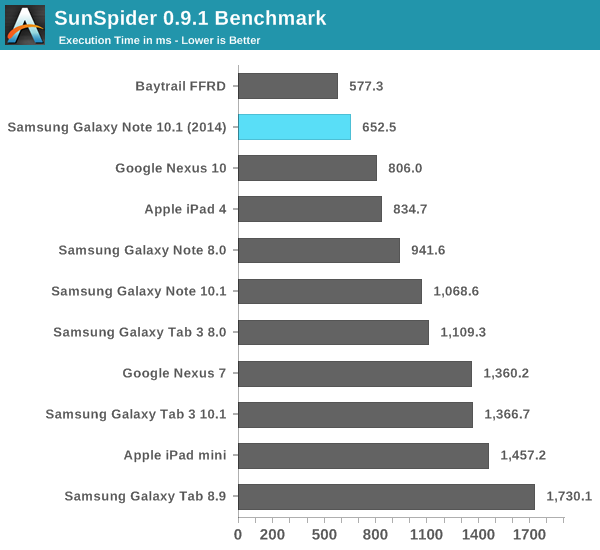
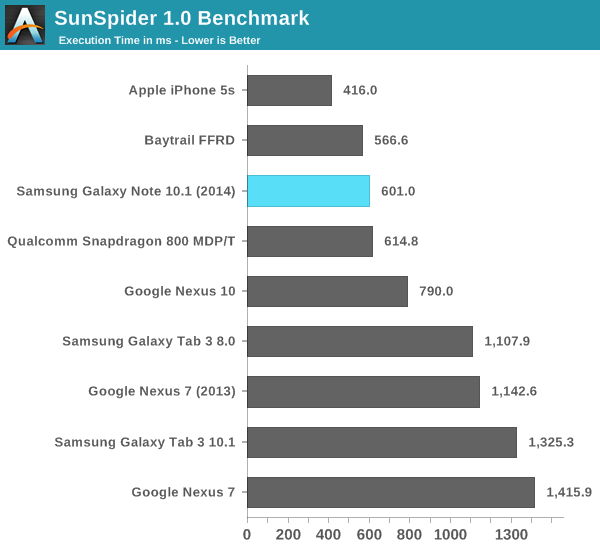
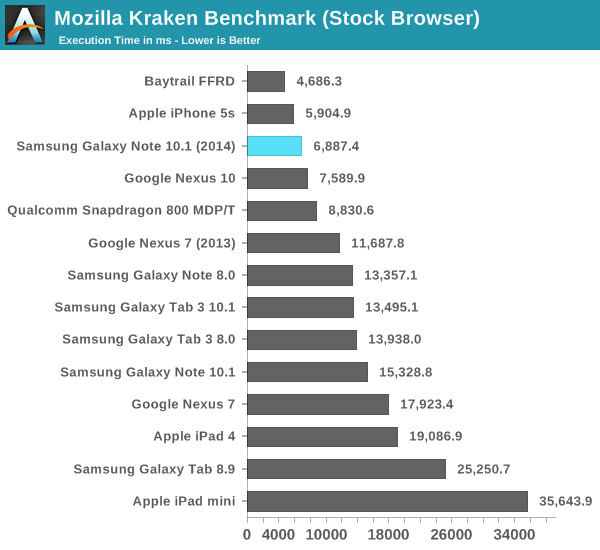
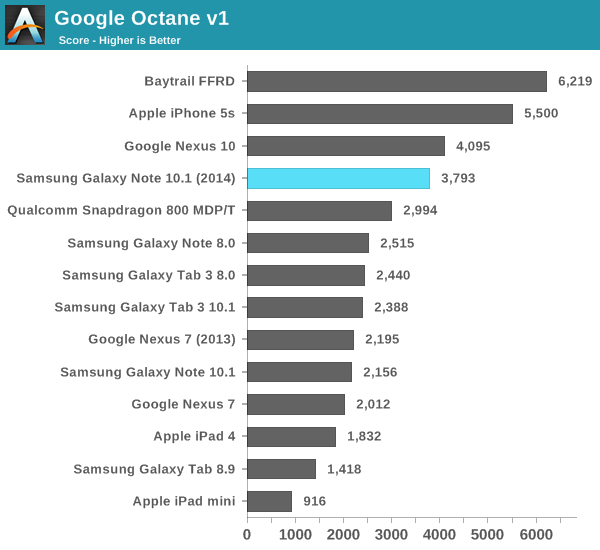
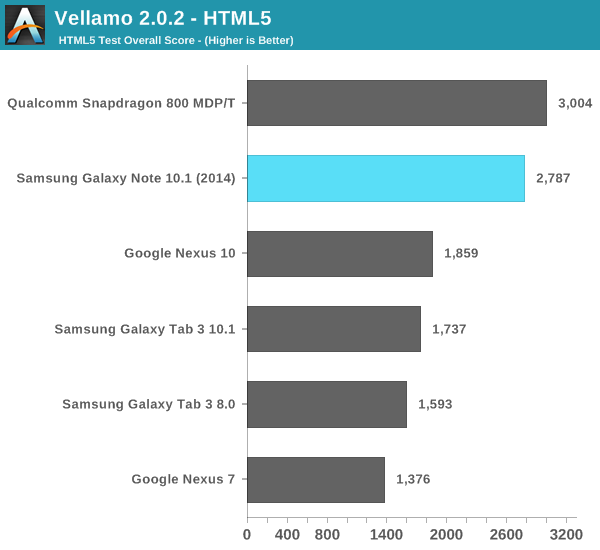



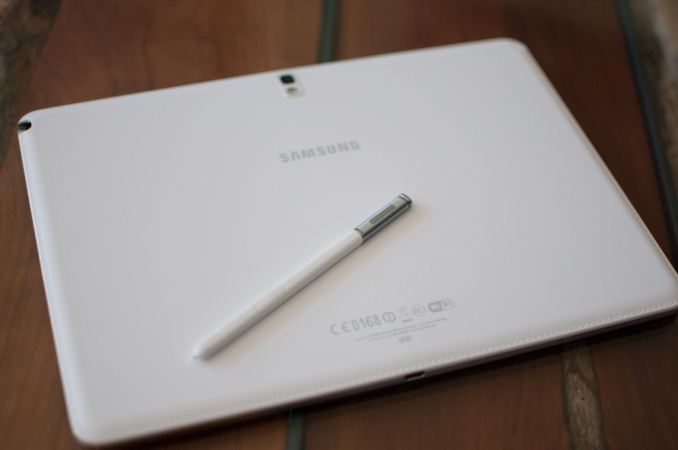
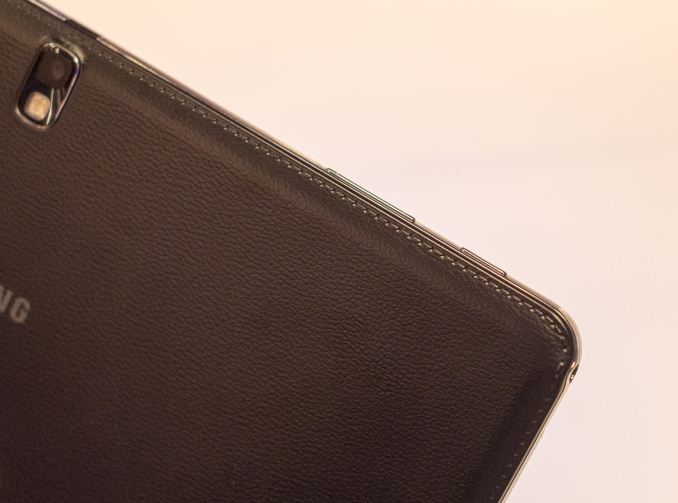








97 Comments
View All Comments
misfit410 - Thursday, October 3, 2013 - link
I have an iPad 3 and an iPad mini, my experience is not smooth on either.. can't even browse engadget or Gawker without crashing safari.badcode - Tuesday, October 8, 2013 - link
I thought that was only occurring on my ipad 1 because it was so old. Now I know I will either wait for a Tegra 4 tablet or get a surface pro 2. Thanks for the infocrankerchick - Saturday, October 12, 2013 - link
Late reading the review, but I wish you guys had touched on how the device runs in actual use. Benchmarks are nice, but some want to know how laggy the tablet feels using it, especially in multi-window mode or with the stylus. That's what makes this tablet unique, and it doesn't seem to be touched on at all.sundragon - Wednesday, October 2, 2013 - link
Interesting as this is typical excuse I read when people blast Apple for being slow but when when someone introduces a faster Android based device, the same excuse isn't used.A 1.3 GHz ARMv8 based dual core CPU (designed by Apple, fabbed by Samsung) is beating a 1.8GHz Samsung ARMv7 A15 quad core CPU (designed by ARM, fabbed by Samsung).
All the excuses for javascript, multi-threaded performance, etc are BS.
Will you use the same excuse when Samsung introduces an ARMv8 64-bit Exynos next year in the Samsung Galaxy 5?
If it beats the 5S willl ya all be making excuses for Android being different from iOS?
I think not, I think admitting to being biased is a bit better than making excuses...
P.S. the chart Anand created to show the cheating on the Android side of things (except Motorola/Google) is telling as to the business ethics of the companies listed...
Now go polish a turd and try to sell it to me...
IUU - Thursday, October 3, 2013 - link
Apple is not slow but its intentions are sinister.I would rather buy "a polished turd" from any other "incompetent Apple rival" than let Apple destroy the progress of computing.
And by the way... Apple has offered a palatable computing performance only with its recent mobile products. Yet, they can't get over the fact that they actually had to incorporate performance parts into their devices, and they started to iterate the same old crap about "user experience", hoping they ultimately sell outdated tech with high profits.
I won't say more, I am fiercely anti-apple, but there are some very good reasons for this, whether you want to believe it or not.
ESC2000 - Sunday, October 6, 2013 - link
Or to put it more simply, competition is good for us all. Consumers would be screwed if everyone bought only apple, but I get the sense from the rabid apple lovers that ideally we'd all use apple products for everything. Thank God that's only a fantasy. Apple's awesome hardware is totally wasted on its closed down gimp OS.jasonelmore - Friday, October 4, 2013 - link
That's the thing, 90% of the gains werent from amazin soc design, it was from moving to a 64 bit instruction set, which dropped laggy legacy support of the past 20 years that slowed things. Moving forward, all these oem's will do the same, and that's when we truly see how good apple's new soc is.ddriver - Tuesday, October 1, 2013 - link
Not really, while it is not a reference ARM design, apple have only modified it slightly, but it is still a conventional arm v8 chip.Note that the benchmarks the 5s is better at are:
1 - JS benchmarks using different browsers with different JS engine implementations
2 - single threaded, which plays in favor of apple, since they have lower core count
The snapdragon 800 is actually considerably faster in HPC workloads. The A7 has better single threaded performance, but not that much higher to make up for it...
Naturally, I don't expect from someone with your screen name to be capable of objectivity. And no, I don't own a single samsung device, so I am not biased even a little bit. If anything, I am a Dell and Asus guy...
MrSpadge - Tuesday, October 1, 2013 - link
I really dislike Apples closed software environment - but you have to give credit where it's due. The 2-core A7 at 1.3 GHz beating this 4+4 core with A15's at a maximum of 1.8 GHz is really impressive. Apple is doing something right here! And seriously, who cares about HPC workloads on a tablet?ddriver - Tuesday, October 1, 2013 - link
So why do you need high performance on a tablet if high-performance computing is not needed on a tablet(or a phone for that matter)?I mean it is either that we need and care about performance or not. If we don't why would a faster chip be considered an advantage? Because it can do something in 0.002 seconds rather than 0.0025?